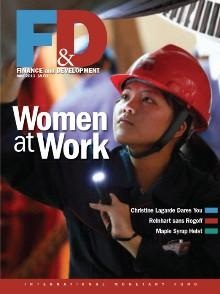
Typical street scene in Santa Ana, El Salvador. (Photo: iStock)
IMF Survey : Better Gender Balance at Top Helps Both Women and Men
June 4, 2013
- Exposure to female leaders improves people’s attitudes toward all women
- Women bring diverse views that improve political and corporate decision making
- International institutions have responsibility to design policies that tap female potential
Women have made many gains but reductions in gender disparity haven’t yet translated into equal opportunities, says the IMF’s Finance & Development (F&D) magazine, which focuses in its recently released June issue on how changes in the balance of power for women at work can improve the global economy.

Woman installing a thermal power unit at an electricity power plant in Qujing, Yunnan Province, China; more women in the labor force, especially in aging populations, boosts economic growth (photo: Zhang Jiang Tao/Redlink/Corbis)
GENDER ISSUES
Life is improving for women around the globe. Women are now more educated than men in many countries, for example. But equality at the top—in economic policymaking, in politics, in jobs that offer decision-making power—remains an aspiration. Achieving it would change the world altogether and translate into good news for both women and men.
The recently released June 2013 issue of F&D magazine looks at how U.S. female economists view national issues compared with their male counterparts; how a policy experiment in India proves putting women in power can change attitudes toward all females; and how giving women real power can make businesses in Africa blossom. And Christine Lagarde dares women to think, speak, and operate differently—to make a world of difference, now and in the future.
Policy design is important path to equity
Women’s entry to the workplace and halls of government in the 20th century was a major turning point toward gender equity. But the gains made since then, while impressive in areas like education and health, have not been enough to realize women’s full potential, according to IMF economist Janet Stotsky. Some of the onus to effect change is on organizations that can design policies to tap that potential. For example, writes Stotsky, “international financial institutions like the IMF can help reform tax and financial legislation to ensure equal rights for women, or help design a social safety net that factors in the disproportionate poverty of households headed by women.”
Women are too often second-class citizens even when they are admitted to the labor market. They are paid less, hold few corporate board seats, and are being hit harder by the global economic crisis than men, says IMF Managing Director Christine Lagarde. But making things better for women doesn’t help them alone. More women working and in positions of power boosts economic growth, tempers risky decisions, builds human capital. Put simply, women’s different viewpoint brings a different perspective to the table. Lagarde calls it “daring the difference.”
As more women enter previously male-dominated professions like economics, the change in gender balance will help shape policy debates. A study by University of Nebraska—Lincoln professor Ann Mari May surveyed male and female members of the American Economics Association and found important differences in their views. The subjects men and women agreed on implied that male and female economists start from the same basic assumptions about how people behave. But women were more likely to accept government intervention to address social inequities such as inadequate access to health care and poor labor standards.
May concludes that the increasing number of women economists “is likely to contribute to an environment in which individuals expect differences in perspectives and work harder to assimilate different ideas.” “Ultimately,” she writes, “we hope our differences will result in better policy.”
Female leaders change voters’ perceptions
A policy experiment in India, which mandated through quotas that one-third of local leadership positions be filled by women, resulted in measurable changes in perceptions and behaviors toward women. Harvard economist Rohini Pande and the IMF’s Petia Topalova surveyed households in nearly 500 Indian villages to study the effect of exposure to women in power. They found after repeated exposure to female leaders, voters’ perceptions of women’s effectiveness as leaders improved.
The most important finding, according to Pande and Topalova, was that being exposed to female leaders raised the aspirations parents have for their daughters and the aspirations teenage girls have for themselves. “India’s experience demonstrates that putting women in leadership positions can catalyze change.”
Women need to move to high-return activities
It’s not enough just to increase the numbers of women in the workplace, argue Mark Blackden, an independent consultant working on gender issues, and the World Bank’s Mary Hallward-Driemeier. The authors drew on two recent World Bank studies of gender gaps in sub-Saharan African economic opportunities. They found that such gaps stem less from whether or not women work than from differences in the types of activities women and men pursue.

Female labor force participation in the region is high: few women can afford not to work. But women tend to work in smaller firms, in the informal sector, and in traditional women’s industries, all of which produce lower economic returns. “Expanding women’s economic empowerment is about enabling more women to operate in activities that offer higher returns,” write Blackden and Hallward-Driemeier. Policy reforms that ensure women’s rights—to enter into contracts, move freely, and own property and control assets in their own names—would help make this happen.
Women are assessed more on performance than potential
Even on Wall Street, women continue to face barriers to success. INSEAD finance professor Lily Fang observes that only 1.5 percent of large U.S. corporations’ chief executive officers are women. This reflects women’s lack of progress in business in general. Women outnumber males as law school and medical school graduates. But they make up only 35 percent of enrollees in masters of business administration programs and actually lost ground in pay vis-a-vis their male counterparts in the past decade.
Fang examined Wall Street stock analysts’ performance and career outcomes. She found that women analysts are better educated than their male colleagues, just as well connected, and as likely to win the “all star” status awarded by Institutional Investor magazine based on a survey of investment managers. While connectedness is one of the strongest factors in a male analyst’s success, for women it was their performance as measured by forecast accuracy and education that mattered. Fang concludes that it is easier for women to demonstrate technical and measurable skills than to overcome potential bias in subjective evaluations.
â– Also in the June 2013 issue of F&D, F&D authors analyze the behavior of emerging market private investors, who are increasingly putting their funds in overseas assets; explain that China’s working-age population is poised to decline, with big implications for China and the rest of the world; and describe what an $18 million maple syrup heist tells us about the economics of supply management. In the People in Economics column, F&D profiles Carmen Reinhart, the oft-cited Harvard economist whose 2010 research with Kenneth Rogoff on the impact of government debt on economic growth was recently in the news.


